Aquatic Nuisance Species (ANS)

Aquatic nuisance (or invasive) species (ANS) are nonindigenous species that threaten the diversity or abundance of native species or the ecological stability of infested waters, or commercial, agricultural, aquacultural, or recreational activities dependent on such waters. ANS include nonindigenous species that may occur in our waters and that presently or potentially threaten ecological processes and natural resources. In addition to adversely affecting activities dependent on waters of the United States, ANS adversely affects individuals, including health effects.
Invasive species affect ecosystem structure and function, resulting in a loss of biodiversity or unique habitats. They cause economic and environmental damage as well as detrimentally affect human use of our natural resources by permanently degrading the habitats they invade, hindering economic development, reducing or eliminating recreational and commercial activities, decreasing the aesthetics of our environment and serving as vectors of disease.
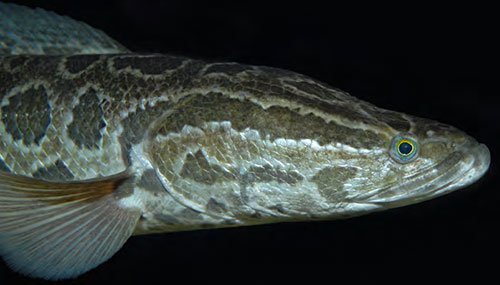
If you observe Apple Snails or their pink egg masses in the wild, please report by visiting the Aquatic Nuisance Species Report above.
Giant Apple Snail Q & A
Giant apple snails (Pomacea maculata) are native to South America, but have been introduced and established in many southeastern states. If introduced, they could harm aquatic habitats used by native fish and wildlife, and Arkansas’s rice industry. They also carry parasites that can be transmitted to humans through consumption of uncooked snail meat and contaminated produce.
Aquarium releases, hitchhiking on boats exposed to infested waters and hitching a ride in live crawfish shipments are the top three ways apple snails can be brought to Arkansas.
- Also called Island Apple Snails.
- Invasive freshwater snails native to South America
- Herbivore – feeds on aquatic plants
- Key features: (see pictures below): large snail (adults 2 to 6 inches tall) with golden-yellow to dark brown shell that has 3 to 4 whorls. Flap called an operculum can close shell opening
- Overpopulate and out-compete native species
- Destroy aquatic habitats used by native fish and wildlife
- Rice crop pest – could impact rice industry in Arkansas
- Known to carry rat lungworm (a parasite) that can infect mammals (including humans) through the consumption of raw or uncooked snail meat or contaminated produce
- No, but if introduced they could establish and cause ecological and economic harm in Arkansas.
- Live crawfish sold for human consumption. Inspect all live crawfish bags for snails! If larger than a quarter, it’s most likely an apple snail.
- Shoreline and aquatic vegetation in ditches, ponds, lakes, rivers or streams.
- Bright pink egg masses (about the size of your thumb) are laid just above the water line on vegetation, tree trunks and other objects.
- Take a picture and report the location immediately to AGFC at www.agfc.com/ans or immediately call the Aquatic Nuisance Species (ANS) Program Coordinator, Matt Horton, at 501-604-0485.
- Dispose of snails by double-bagging in a garbage bag and seal by tying or taping closed. If possible, place the sealed bag in the freezer for at least 24 hrs., throw away the sealed bag in a trash receptacle, and wash hands thoroughly with hot soapy water if snails are handled.
- DO NOT discard snails onto the ground, in a ditch, pond or other natural environment or keep as a pet. As a reminder, crawfish sold for human consumption are not legal to release, stock or use as bait.
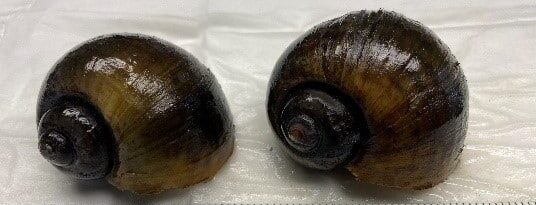
Apple Snail Reporting Form
Report Apple Snails observed in live crawfish purchases or shipments in Arkansas.
 | 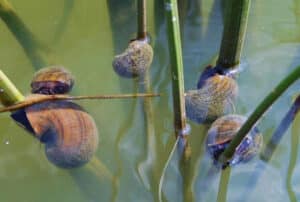 |
| Apple snails lay thousands of eggs in pink clusters just above the water and can overpopulate an area quickly. Photo courtesy of Jess Van Dyke, Snail Busters, LLC. Bugwood.com. | Giant apple snails are voracious eaters and can cause serious damage to rice crops. Photo courtesy of Jess Van Dyke, Snail Busters, LLC. Bugwood.com. |
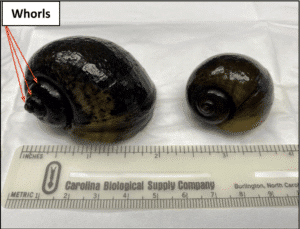 | 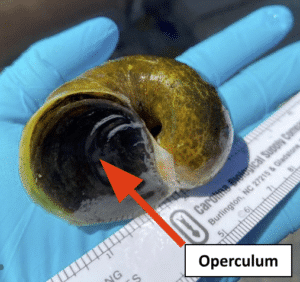 |
| Giant apple snails are larger than any native species in Arkansas, as shown by their size next to the ruler. Their shell also has characteristic whorls. AGFC photo. | A Giant apple snail with a closed operculum, or flap, used to seal the shell opening. AGFC photo. |
Invasive Species Identification
Listed below are all aquatic nuisance species (ANS), organized by taxa, that have been detected in Arkansas. Links to the USGS Nonindigenous Aquatic Species (NAS) database are provided for each species. Click on “Profile” to learn more about the species identification, ecology, home range, means of introduction into the U.S., national distribution, and ecological, economic, and/or human health imapcts.
NOTE: Distribution Maps may not accurately represent the current distribution of a species in Arkansas. Click on “Images” to view pictures of each species, most of which are linked to the University of Georgia’s Center for Invasive Species and Ecosystem Health website, or the University of Florida’s Center for Invasive Aquatic Plants website.

- Brazilian Waterweed (Egeria densa)
- Common Reed (Phragmites australis)
- Cuban Bulrush (Oxycaryum cubense)
- Curly-leaf Pondweed (Potamogeton crispus)
- Didymo (Didymosphenia geminate)

- Duck Lettuce (Ottelia alismoides)
- Eurasian Watermilfoil (Myriophyllum spicatum)




- Amphibian Chythrid Fungus (Batrachochytrium dendrobatidis)
- Catfish Trematode (Bolbophorus damnificus)
- Parasitic Copepods (Achtheres sp.)
- Infectious Pancreatic Necrosis

Essential resources for combatting invasive species in Arkansas, offering practical guidance and strategies to protect native wildlife and habitats.
Prevention is the first line of defense
Everyone can make a difference in the fight against invasive species by learning about how to prevent their introduction and movement.
- Learn to recognize common invaders and keep an eye out for signs of new ones.
- Report sightings immediately by filling out the Aquatic Nuisance Species Form
- Inspect boats, trailers, and recreational equipment before use and after use.
- Remove all plants and animals and dispose of these organisms where they will not reenter the water.
- Thoroughly clean and drain all boats, kayaks, canoes, and recreational gear after use.
- Allow watercraft to dry completely before launching into another body of water.
- Do not release live fish, including bait, into a new body of water.
- Buy pets from reputable dealers whose non-native animals are properly labeled, legally imported, and not harboring invasive pests and diseases.
- Do not release unwanted pets into the environment. If you no longer want your pet, return it to a local pet shop for resale or trade, give it to another hobbyist, or donate it to a school, nursing home, or hospital.
- Avoid growing or buying plants known to be invasive. Contact your or state Department of Natural Resources or local plant societies of a list of plants native to your area.
- Don’t dump aquatic plants or aquarium water into local waters. Many plants for water gardens and aquaria are highly invasive.
- Take action! Join a volunteer invasive species monitoring or eradication group. These outings are a great way to get some exercise, meet new friends, and gain the satisfaction of knowing that you’re helping to protect our environment.
Read the publication: Don’t Let It Loose!



